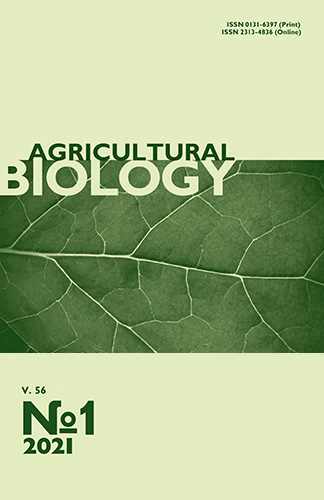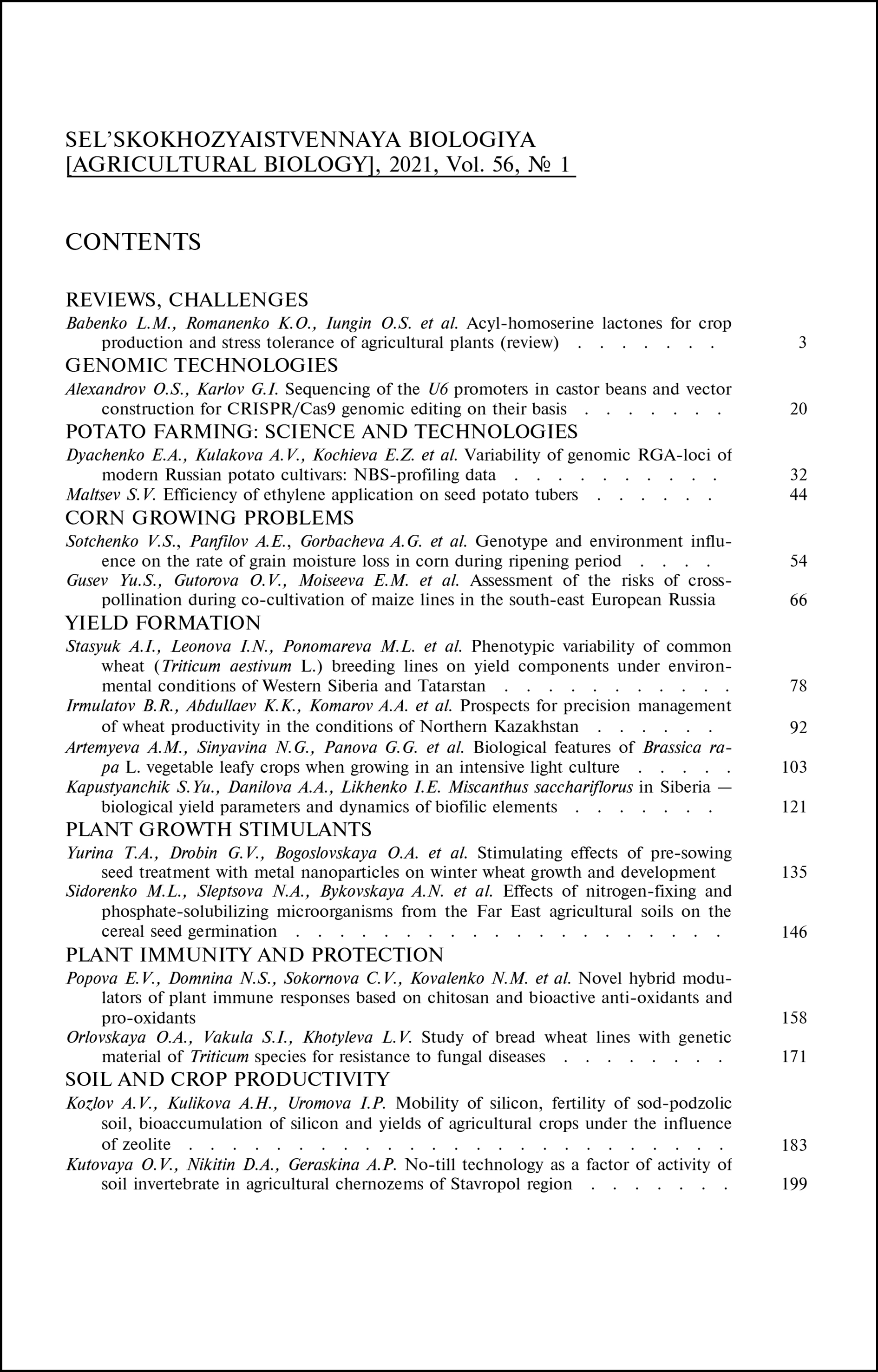doi: 10.15389/agrobiology.2021.1.103eng
UDC: 635.33:581.1:631.588.5
BIOLOGICAL FEATURES OF Brassica rapa L. VEGETABLE LEAFY CROPS WHEN GROWING IN AN INTENSIVE LIGHT CULTURE
А.М. Artemyeva1, 2 ✉, N.G. Sinyavina2, G.G. Panova2, Yu.V. Chesnokov2
1Federal Research Center Vavilov All-Russian Institute of Plant Genetic Resources, 42-44, ul. Bol’shaya Morskaya, St. Petersburg, 190000 Russia, e-mail akme11@yandex.ru (✉ corresponding author);
2Agrophysical Research Institute, 14, Grazhdanskii prosp., St. Petersburg, 195220 Russia, e-mail sinad@inbox.ru, gpanova@agrophys.ru, yuv_chesnokov@agrophys.ru
ORCID:
Artemyeva A.M. orcid.org/0000-0002-6551-5203
Panova G.G. orcid.org/0000-0002-1132-9915
Sinyavina N.G. orcid.org/0000-0003-0378-7331
Chesnokov Yu.V. orcid.org/0000-0002-1134-0292
Received May 12, 2020
One of the main components of the successful production of plant products is the choice of crops with a high realization of their production potential under the formed conditions, including in the conditions of intensive light culture. The problem of compensating or eliminating the deficit of green crops is currently quite acute in Russia and in the world. The genetic diversity of the most widespread green brassicas plants of the species Brassica rapa L. for use in protected ground facilities has developed in Southeast Asia and includes numerous morphotypes of Chinese cabbage, pakchoi, tatsoi, wutacai, mizuna, and leafy turnip. In Russia, leafy B. rapa vegetables are used to a limited extent, mainly as salad vegetables. The main areas of B. rapa crops breeding for artificial light culture include a high growth rate (the duration of vegetative period is not more than 28-35 days, depending on the biological characteristics of the crop), the yield is not less than 3-8 kg/m2, depending on crops, a certain compact plant habit, high quality of leaves, valuable biochemical composition, resistance to early bolting, resistance to possible low light and high air temperature, suitability for growing in a thin layer of soil or hydroponics. The biological features of the diversity of B. rapa leafy crops as sources for breeding for intensive light culture conditions have not been sufficiently studied, first of all, this concerns little-known crops (tatsoi, wutacai, mizuna) and certain morphotypes within common crops (Chinese cabbage and pakchoi). In this study, for the first time, we studied the wide genetic diversity from the Russian worldwide B. rapa collection of the Russian Federation, stored in the VIR, and morphotypes within them (72 accessions), including genotypes contrasting in morphological characteristics, under different supply light intensity for the development of energy-saving agro-technologies in intensive light culture. For the first time, correction factors were determined for calculating the leaf surface area from easily measured linear dimensions for each studied crop and type of leaves, which will speed up the calculations of photosynthesis characteristics. A different degree of variation in the variability of the size and weight of plants of various crops, depending on the illumination, is shown, the highest in Chinese cabbage and leafy turnip. It was found that the intensity of the light regime is largely determined the increase in the productivity of plants of all studied crops, mostly of Chinese cabbage and pakchoi and leafy turnip. High-yielding accessions of Chinese cabbage, pakchoi and leafy turnip were identified (more than 6.3 kg/m2 for 28 days of growing season). The studied accessions of wutacai and mizuna are low-yielding and have a longer growing season, but are of interest as vegetables for functional nutrition and for decorative purposes. Semi-cabbage types of Chinese cabbage (Shantung, Santo, Xiao), which are of primary interest for light culture, have been identified. We recommend Chinese cabbage accessions vr.k-1375, Bice (vr.k-1376), and pakchoi k-647 for thickened cultivation,, and pakchoi Extra Dwarf Pack Choi (vr.k-1405 ) and tatsoi Xiao Ba Je Ta Cai (k-695) for growing with a small distance between the shelves of 25 cm. Accessions of Chinese cabbage Chokurei (k-177), Tokyo Bekana (k-395), Zao Shi No. 5 (vr.k-1120), and Fun jen F1 (vr.k-1410) showed the highest salad qualities of the leaves. Under the conditions of a biopolygon, we managed to determine accessions with a stable manifestation of the traits, of early maturity and high productivity, practically independent of light intensity. These are accessions of Chinese cabbage Harumaki Shin Santousai (k-270), Tokyo Bekana (k-395), Xiaobaikou (k-74), pakchoi Kangre 605 (vr.k-1131), Gai Lang Jin Pin 25 F1 (vr.k-1124). In addition, it was shown that the Chinese accession of Chinese cabbage Zao Shi No. 5 (vr.k-1120) and the Russian cultivar of the leafy turnip Selecta (vr.k-1371) have increased the activity of the photosynthetic apparatus. The obtained data on the crops in general and the determined accessions of B. rapa are of interest for the practice of vegetable growing, in the development of elements of cultivar technology of B. rapa crops under conditions of light culture and as sources of valuable traits in breeding programs, including the development of city farming.
Keywords: Brassica rapa L., leafy crops, controlled-environment agriculture, artificial lighting, valuable traits, genetic sources.
REFERENCES
- Pivovarov V.F., Startsev V.I. Kapusta, ee vidy i raznovidnosti [Cabbage types and varieties]. Moscow, 2006 (in Russ.).
- Plant factory: an indoor vertical farming system for efficient quality food production. T. Kozai, G. Niu, M. Takagaki (eds.). Academic Press, 2019.
- Beacham A.M., Vickers L.H., Monaghan J.M. Vertical farming: a summary of approaches to growing skywards. The Journal of Horticultural Science and Biotechnology, 2019, 94(3): 277 CrossRef
- Dou H., Niu G., Gu M., Masabni J. Morphological and physiological responses in Basil and Brassica species to different proportions of red, blue, and green wavelengths in indoor vertical farming. Journal of the American Society for Horticultural Science, 2020, 145(4): 267-278 CrossRef
- Park J.E., Kim J., Purevdorj E., Son Y.J., Nho C.W., Yoo G. Effects of long light exposure and drought stress on plant growth and glucosinolate production in pak choi (Brassica rapa subsp. chinensis). Food Chemistry, 2021, 340: 128167 CrossRef
- Baek M.W., Choi H.R., Solomon T., Jeong C.S., Lee O.H., Tilahun S. Preharvest methyl jasmonate treatment increased the antioxidant activity and glucosinolate contents of hydroponically grown pak choi. Antioxidants, 2021, 10(1): 131 CrossRef
- Loconsole D., Cocetta G., Santoro P., Ferrante A. Optimization of LED lighting and quality evaluation of romaine lettuce grown in an innovative indoor cultivation system. Sustainability, 2019, 11(3): 841 CrossRef
- Cartea M.E., Francisco M., Soengas P. Phenolic compounds in Brassica vegetables. Molecules, 2010, 16: 251-280 CrossRef
- Golubkina N.A., Sirota S.M., Pivovarov V.F., Yashin A.Ya., Yashin Ya.I. Biologicheski aktivnye soedineniya ovoshchei. Moscow, 2010 (in Russ.).
- Solov'eva A.E., Artem'eva A.M. Trudy po prikladnoi botanike, genetike i selektsii, 2012, 169: 137-146 (in Russ.).
- Podsędek A. Natural antioxidants and antioxidant capacity of Brassica vegetables: A review. LWT-Food Science and Technology, 2007, 40(1): 1-11 CrossRef
- Al-Kodmany K. The vertical farm: a review of developments and implications for the vertical city. Buildings, 2018, 8(2): 24 CrossRef
- Shamshiri R.R., Kalantari F., Ting K.C., Thorp K.R., Hameed I.A., Weltzien C., Ahmad D., Shad Z.M. Advances in greenhouse automation and controlled environment agriculture: a transition to plant factories and urban agriculture. International Journal of Agricultural and Biological Engineering (Beijing), 2018, 11(1): 1-22 CrossRef
- Alexandratos N., Bruinsma J. World agriculture towards 2030/2050: the 2012 revision. ESA Working Paper No. 12-03. Rome, FAO, 2012 CrossRef
- FAO. 2019. FAO framework for the Urban Food Agenda. Rome, 2019 CrossRef
- Kolpakov N.A., Reshetnikova I.M. Gavrish, 2012, 6: 10-12 (in Russ.).
- Kolpakov N.A., Chernysheva N.N., Fedorova M.I., Burkova E.V., Vol Yu.S. Vestnik Altaiskogo GAU, 2015, 12(134): 5-9 (in Russ.).
- Polyakova M.N., Martirosyan Yu.Ts., Dilovarova T.A., Kosobryukhov A.A. Photosynthesis and productivity of basil plants (Ocimum basilicum L.) under different irradiation. Sel'skokhozyaistvennaya biologiya [Agricultural Biology], 2015, 50(1): 124-130 CrossRef
- Kuleshova T.E., Chernousov I.N., Udalova O.R., Anikina L.M., Khomyakov Yu.V., Aleksandrov A.V., Seredin I.S., Feofanov S.V., Shcheglov S.A., Gall' N.R., Panova G.G. Biofizika, 2020, 65: 112-124 CrossRef (in Russ.).
- Olle M., Virsile A. The effects of light-emitting diode lighting on greenhouse plant growth and quality. Agricultural and Food Science, 2013, 22(2): 223-234 CrossRef
- Lin K.H., Huang M.Y., Huang W.D., Hsu M. H., Yang Z. W., Yang, C. M. The effects of red, blue, and white light-emitting diodes on the growth, development, and edible 224 quality of hydroponically grown lettuce (Lactuca sativa L. var. capitata). Scientia Horticulturae, 2013, 150: 86-91 CrossRef
- Li H., Tang C., Xu Z., Liu X., Han X. Effects of different light sources on the growth of non-heading Chinese cabbage (Brassica campestris L.). Journal of Agricultural Science, 2012, 4: 262-273 CrossRef
- Qian H., Liu T., Deng M., Miao H., Cai C., Shen W., Wang Q. Effects of light quality on main health-promoting compounds and antioxidant capacity of Chinese kale sprouts. Food Chemistry, 2016, 196: 1232-1238 CrossRef
- Panova G.G., Udalova O.R., Kanash E.V., Galushko A.S., Kochetov A.A., Priyatkin N.S., Arkhipov M.V., Chernousov I.N. Zhurnal tekhnicheskoi fiziki, 2020, 90(10): 1633-1639 CrossRef (in Russ.).
- Panova G.G., Chernousov I.N., Udalova O.R., Aleksandrov A.V., Karmanov I.V., Anikina L.M., Sudakov V.L., Yakushev V.P. Doklady Rossiiskoi akademii sel'skokhozyaistvennykh nauk, 2015, 4: 17-21 (in Russ.).
- Ermakov E.I., Zheltov Yu.I., Mil'to N.E., Kucherov V.I. Pochvogrunt dlya vyrashchivaniya rastenii «Agrofit». Patent na izobretenie RF 2081555 (RF) MPK A 01 G 9/10. Zayavl. 13.07.1993. Opubl. 20.06.1997. Byul. № 17.1997 [Soil carrier for growing plants «Agrofit». Patent RF 2081555 (RF) MPK A 01 G 9/10. Appl. 13.07.1993. Publ. 20.06.1997. Bull. № 17.1997] (in Russ.).
- Boos G.V., Dzhokhadze T.I., Artem'eva A.M., Krivchenko V.I., Simon A.M., Timoshenko Z.V., Petrovskaya N.N., Vlasova E.A., Barashkova E.A., Sinel'nikova V.N., Barashkova E.A., Ivakin A.P., Ermakov A.I., Voskresenskaya V.V. Metodicheskie ukazaniya po izucheniyu i podderzhaniyu mirovoi kollektsii kapusty [Guidelines for the study and maintenance of the world cabbage collection]. St. Petersburg, 1988 (in Russ.).
- Lutova L.A., Provorov N.A., Tikhodeev O.N., Tikhonovich I.A., Khodzhaiova L.T., Shishkova S.O. Genetika razvitiya rastenii [Genetics of plant development]. St. Petersburg, 2000 (in Russ.).
- Artem'eva A.M., Solov'eva A.E., Berensen F.A., Kocherina N.V., Chesnokov Yu.V. Ecological and genetic evaluation of morphological and biochemical characters of quality in Brassica rapa L. accessions from VIR collection. Sel'skokhozyaistvennaya biologiya [Agricultural Biology], 2017, 52(1): 129-142 CrossRef
- Donory i istochniki dlya selektsii listovykh ovoshchnykh kul'tur vida Brassica rapa L. Katalog mirovoi kollektsii VIR /Sost. A.M. Artem'eva [Donors and sources for selection of leafy vegetable crops of the species Brassica rapa L. Catalogue of VIR world collection]. St. Petersburg, 2004 (in Russ.).
- Van Ts. Morfofiziologicheskie reaktsii na svetovye usloviya rastenii raznykh biomorf iz roda Brassica L. Avtoreferat kandidatskoi dissertatsii [Morphophysiological reactions to light conditions of plants of different biomorphs from the genus Brassica L. PhD Thesis]. St. Petersburg, 2007 (in Russ.).
- Konyaev N.F. Doklady VASKHNIL, 1970, 9: 43-46 (in Russ.).
- Konyaev N.F. Nauchnye osnovy vysokoi produktivnosti ovoshchnykh rastenii [Fundamentals of high productivity of vegetable plants]. Novosibirsk, 1978 (in Russ.).
- Nikolenko V.V., Kotov S.F. Ekosistemy, ikh optimizatsiya i okhrana, 2010, 2: 99-105 (in Russ.).
- Kiseleva N.S. Method of determination of pear leaf area on linear measurements by calculation of correction factors and variation statistics approach. Sel'skokhozyaistvennaya biologiya [Agricultural Biology], 2017, 52(2): 211-217 CrossRef
- Weiguo F., Pingping L., Yanyou W., Jianjian T. Effects of different light intensities on anti-oxidative enzyme activity, quality and biomass in lettuce. Horticultural Science, 2012, 39(3): 129-134 CrossRef
- Fu Y., Li H., Yu J., Liu H., Cao Z., Manukovsky N.S., Liu H. Interaction effects of light intensity and nitrogen concentration on growth, photosynthetic characteristics and quality of lettuce (Lactuca sativa L. var. youmaicai). Scientia Horticulturae, 2017, 214: 51-57 CrossRef
- Viršilė A., Brazaitytė A., Vaštakaitė-Kairienė V., Jankauskienė J., Miliauskienė J., Samuolienė, G., Duchovskis P. Nitrate, nitrite, protein, amino acid contents, and photosynthetic and growth characteristics of tatsoi cultivated under various photon flux densities and spectral light compositions. Scientia Horticulturae, 2019, 258: 108781 CrossRef
- Hao X., Jia J., Mi J., Yang S., Khattak A. M., Zheng L., Wang M. An optimization model of light intensity and nitrogen concentration coupled with yield and quality. Plant Growth Regulation, 2020, 92(2): 319-331 CrossRef
- Zanewich K.P., Rood S., Southworth C.E., Williams P.H. Dwarf mutants of Brassica: responses to applied gibberellins and gibberellin content. Journal of Plant Growth Regulation, 1991, 10(1): 121-127 CrossRef












